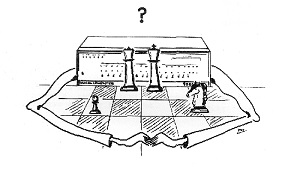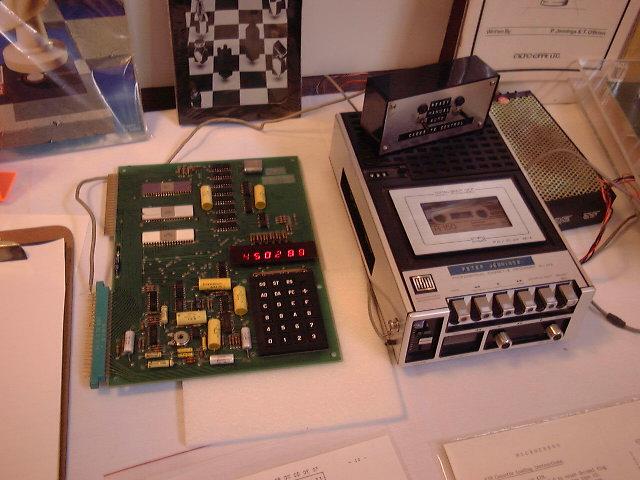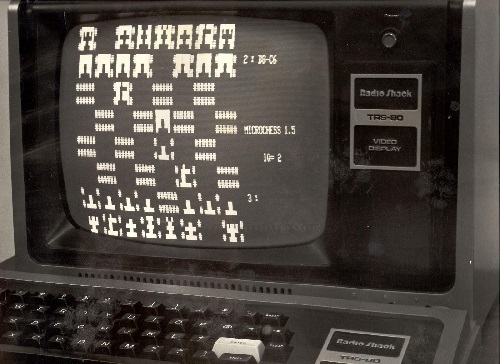MicroChess

MicroChess,
the first commercially successful chess program for 6502 [2] and 8080/Z80 [3] based microcomputers, such as KIM-1 and TRS-80 [4] , developed by Peter Jennings in 1976 [5] . MicroChess 1.5 was base for the programs for the dedicated Commodore ChessMate (1978) and the Novag Chess Champion MK II (1979) [6] .
Contents
Images
KIM-1
TRS-80
Development
Peter Jennings in his Oral History about the development of MicroChess on the KIM-1 [9] :
And if people were using the KIM-1 they weren't going to have it, the majority of people who had a KIM-1 that’s what they had, was just the KIM-1. So I mean I never thought about it in terms of could I put it on some bigger computer, I really at that point was saying “Okay this is what I'm going to do,” and so I treated the problem that way and looked at okay, how do you store the positions, how do you store the moves, how do you do it with the minimum amount of memory, how do you store the tree of what you’ve created, and ...
Well I know I didn't store the whole board, because it was simpler to just store the number of pieces, there are fewer pieces than there are squares on the board, and then what I would do is I would make a move, so I would only store the tree of moves and moves would always be done in a certain order, so you always knew that you could sort of start with this move, then go to that move, then go to that move, go through a sequence of potential types of moves. So the order of how moves would be generated was always the same. So you could then go through one move at a time and I would store the first move and then I would reverse the board and then just give it to the computer, give it to the program in the same way that it had looked at the first position, so all I had to store at that point was the position and one move. So the amount of storage was kept pretty small and you were basically giving it back to the computer and saying “Okay, reverse the board,” see what that does until you’ve lost something or you’ve gained something and analyze that against the algorithm and give it a score.
You start with exactly the same thing, one point for pawns and two points for knights , three points for bishops, five for rooks, that’s exactly where it started.
Point Values
The point values for 16 pieces, king (11), queen (10), rooks (6), bishops (4), knights (4), and pawns (2) were defined as preinitialized array of 16 bytes, apparently in half pawn units, which overestimates pawns by todays standards [10] :
POINTS db $0B, $0A, $06, $06, $04, $04, $04, $04
db $02, $02, $02, $02, $02, $02, $02, $02
Programming Topics
Namesake
The namesake Microchess 3, released in 1983 by Norgayer Software for the Commodore 64 and Commodore 128 [11] [12] , is an alias of the 1981 program PetChess, developed by Philidor Software [13] [14] [15] , which was, according to Mike Watters, written by Mark Taylor [16] .
See also
Publications
- Peter Jennings (1976). MicroChess, a Chess playing program for the 6502 Microcomputer. pdf, Courtesy of Peter Jennings, The Computer History Museum
- Peter Jennings (1977). MicroChess, a Chess playing program for the 8080 Microcomputer. pdf, Courtesy of Peter Jennings, The Computer History Museum
- Microchess Load Instructions, pdf from The Computer History Museum
- Microchess Order Form, 1976 ca, pdf from The Computer History Museum
- Microchess source code, pdf from The Computer History Museum
- Peter Jennings (1978). Microchess 1.5 Versus Dark Horse. BYTE, Vol. 3, No. 3 » Dark Horse
- What's New? Computer chess; Microchess 1.5; Boris, BYTE, Vol. 3, No. 10, pp. 193, pdf from The Computer History Museum » Boris
- Editor (1981). Chess And Checkers Programs For Atari Personal Computers. Compute!, Issue 010
- John F. White (1981). Survey-Chess Games. Your Computer, August/September 1981
External Links
- Microchess from Wikipedia
- DigiBarn Games: MicroChess 1.5 on the TRS-80 Model 1 » TRS-80
- Classic Computer Chess - ... The programs of yesteryear by Carey, hosted by the Internet Archive [17]
- Aart's Commodore 64 Page by Aart Bik » Commodore 64
- Secret Weapons of Commodore: Microchess by Cameron Kaiser
- Computer Schach by Andre Adrian (German)
- Commodore 64 Emulator - Computer Chess Game Collection - Microchess, The Spacious Mind
- Early Copy Protection on the Apple II, Fadden.com » Apple II, Sargon
- 6502 Microchess on an Arduino » Arduino
- KIM Uno - Summary - KIM-1 replica with MicroChess
References
- ↑ Illustration from Microchess: A Chess Playing Program for the 8080 Microcomputer, 1977, from The Computer History Museum
- ↑ Peter Jennings (1976). MicroChess, a Chess playing program for the 6502 Microcomputer. pdf, Courtesy of Peter Jennings, The Computer History Museum
- ↑ Peter Jennings (1977). MicroChess, a Chess playing program for the 8080 Microcomputer. pdf, Courtesy of Peter Jennings, The Computer History Museum
- ↑ Microchess running on Radio Shack TRS-80 microcomputer, 1976, Courtesy of Peter Jennings and Digibarn, The Computer History Museum
- ↑ Sellam Ismail (2005). Oral History of Peter Jennings. pdf and Video from The Computer History Museum
- ↑ Scisys and Novag : The Early Years from Chess Computer UK by Mike Watters
- ↑ DigiBarn Games: MicroChess 1.5 on the TRS-80 Model 1
- ↑ Microchess running on Radio Shack TRS-80 microcomputer, 1976, Courtesy of Peter Jennings and Digibarn, The Computer History Museum
- ↑ Sellam Ismail (2005). Oral History of Peter Jennings. pdf and Video from The Computer History Museum, pp. 15, 16
- ↑ 6502 source code
- ↑ Microchess – C64-Wiki (German)
- ↑ Commodore 64 Emulator - Computer Chess Game Collection - Microchess 3, The Spacious Mind
- ↑ Game music base - database of Games, Games music and soundtracks | Pet Chess 4000 aka Microchess 3.0
- ↑ Commodore 64 Emulator - Computer Chess Game Collection - Petchess 4000, The Spacious Mind
- ↑ John F. White (1982). Review-Chess Computers. Your Computer, March 1982
- ↑ Chess Computers - The UK Story by Mike Watters
- ↑ Re: Old programs CHAOS and USC by Dann Corbit, CCC, July 11, 2015

